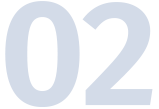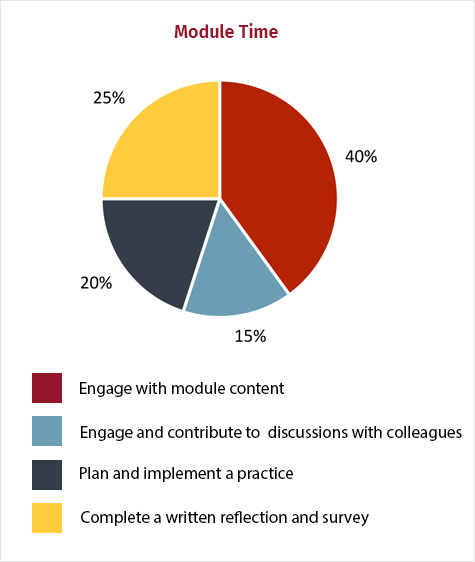ACUE’s Fostering a Culture of Belonging Syllabus

Welcome
Welcome to your ACUE course in Fostering a Culture of Belonging. Consider this a mini graduate course in which you will dedicate 2-3 hours per week engaging with the material, implementing inclusive practices, and composing a written reflection. Each module provides you with various research-based practices designed to increase a sense of belonging across your campus community. Among these, you will select and implement the practice(s) that best suits your goals and your position. The ACUE course is also community-based, and you will have many opportunities to learn from and share ideas with your colleagues about the practices you are learning. Your instructor will guide you through the modules and help to create an environment where questions, conversation, and learning are valued.
Instructor Corner
Some of the ways your instructor provides guidance and encouragement are by:
- sharing pedagogical insights
- leading and contributing to discussions
- posting announcements
Course Overview
To earn the course badge, you will complete four modules, which taken together address the knowledge and skills needed to create more inclusive campus environments. As you engage with each module, you will view videos of inclusive practices featuring faculty, staff, administrators, and students from a wide variety of colleges and universities, as well as experts in the fields of teaching and learning and diversity, equity, inclusion, and belonging. A set of resources designed to help you implement practices and deepen your learning is available, and you will have opportunities to participate in thought-provoking discussions to learn with and from your colleagues. Finally, you will reflect and write about your experiences implementing new inclusive practices. Your reflections will be reviewed by an ACUE National Reader.
Complete the following to earn a badge for each module:
- Engage with module content.
- Implement an inclusive practice
- Write a reflection of the experience.
- Complete the Practice & Reflect II survey.

Module Components
The following table provides a description of the module components.
| Module Component | Description |
|---|---|
| Introduction | Piques your interest and gets you thinking about and relating to the module topics |
| Learning Objectives | States what you will learn as well as the practices you can choose to implement |
| Expert Insights | Delves deeper into some of the module’s practices with further explanations, supporting research, and commentary by nationally recognized experts in the field |
| Course Demonstrations | Shows the effective practices recommended in the module being implemented by instructors, staff, and administrators from across the country in authentic settings |
| Implementation Resources | Provides step-by-step guidance, course resources, and examples designed to help you implement module practices; resources are downloadable |
| Common Challenges & Misconceptions | Provides research-based clarifications and suggestions for addressing common challenges and misconceptions |
| Observe & Analyze | Showcases instructors, staff, and administrators using practices with different levels of proficiency and provides an opportunity to discuss the module practices more deeply with your colleagues |
| Practice & Reflect I | Serves as the culminating activity where you implement a research-based practice that you learned in the module and then reflect upon it |
| Practice & Reflect II | Provides an opportunity to think about what you learned, what you implemented, and what you may implement in the future |
| Note to Future Self | Provides the opportunity for you to note any practices, resources, or insights that resonated as you worked through the module. These notes are available on the “What’s Next Report”. |
| References | Provides a list of instructors, staff, administrators, and experts featured in the module and a list of sources used for module content |

Course Learning Objectives
Completing this course provides you with the following opportunities to:
- Examine how implicit bias may affect your thoughts, decisions, and actions.
- Apply research-based practices to establish an inclusive environment.
- Reduce microaggressions.
- Use practices to address imposter phenomenon and stereotype threat.
- Cultivate an inclusive environment.
- Earn a course badge in Fostering a Culture of Belonging.


Module Names and Descriptions
A truly inclusive and equitable campus environment can be created when campus faculty, staff, and administrators work together, with a common language, to mitigate the impact of implicit bias, microaggressions, imposter phenomenon, and stereotype threat. These topics are recognized in diversity, equity, and inclusion (DEI) research as impactful on both students’ and colleagues’ sense of belonging.
Managing the Impact of Biases
Reducing Microaggressions
Course-takers will reflect on and further examine how their own unconscious or implicit biases can affect the work they do. In addition, course-takers also learn specific practices for managing the impact of implicit biases to foster a greater sense of belonging for students, faculty, staff, and administrators which includes practices for gathering and using feedback to continually improve their work as well as how to approach the community from an asset-based mindset.
Course-takers will consider the impact of microaggressions while also learning to recognize, effectively respond to, and mitigate the impact of microaggressions. The module includes specific practices instructors and staff can use to help others recognize and respond to microaggressions.
Addressing Imposter Phenomenon and Stereotype Threat
Cultivating an Inclusive Environment
Course-takers will learn to recognize indicators of imposter phenomenon and stereotype threat in themselves and others and will acquire specific practices designed to reduce the impact of both, including practices shown to foster a sense of belonging as well as promote a growth mindset.
Course-takers learn practices for creating a more inclusive environment that fosters a sense of belonging for students, faculty, staff, and administrators. Module practices include the need to share a broad diversity of campus resources with students and colleagues to foster a sense of belonging, showing respect for diverse identities and ideas, creating conditions for productive dialogue, and ensuring that courses, programming, and the campus environment are accessible for all students, families, and the community.


The Power of Reflection
ACUE’s model is grounded in the evidence-based process of becoming reflective practitioners. At its core, it is a community-based engagement process that involves learning about, reflecting on, applying, and adjusting the use of evidence-based diversity and inclusion practices. Course-takers who invest fully in the reflective process are most successful at transforming their practices and thereby impacting student outcomes and the success of colleagues. Committing to inclusive practices is likely a lifelong endeavor involving learning, reflecting, implementing, and adjusting our approaches.

“The only way you’re going to learn something new is to do it. You have to apply what you’ve learned . . . then reflect on what worked well, what needs tweaking in the future, what [you’ve] missed. . .”—Stephen Brookfield

“I’ve learned a great deal in this course about how to approach all individuals from all backgrounds with an equity-minded perspective and how to avoid allowing my biases to dictate how I view individuals. Also, I believe that this is an excellent first step toward change and should be made available to everyone at the college.”—ACUE course-taker

Practice and Reflect
Each module presents a variety of inclusive practices, and prior to implementing a practice you should review the rubric and download the Reflection Guide. The Reflection Guide is a Microsoft Word document that you will use to type your reflection assignment and upload as your Practice & Reflect I: Reflection Assignment submission. Using the Reflection Guide provided for each module is the best way to ensure that all rubric requirements are met.
After submitting the written reflection, you will complete a survey about the module experience as a whole. You will be asked to think about what you learned during the module, what you implemented, and what you will implement in the future.
Example: Reducing Microaggressions: Implementation Reflection Guide
| Criteria | Grading Guide | Your reflection |
|---|---|---|
| Which of the practices shared by the experts and faculty in this module were implemented? | Meets: Describes the practice(s) implemented and explains why they were selected | I chose to implement the practice of addressing a microaggression. In a meeting with my reporting graduate assistant discussing a student’s academic performance, I began to notice that he was using incorrect pronouns for a student who uses they/them pronouns. I felt it was important for the GA to be aware of the fact that they were using improper pronouns. |
| Exceeds: Includes an explanation of the steps taken to implement the practice(s) selected | ||
| What impact did this practice have on others? | Meets: Shares how this practice impacted others | While my student may not have been present for the interaction, I hope that it will be a positive impact for them to have the correct pronouns known by all members of our support team in the future. I also believe my GA learned in that moment to be more aware of respecting a student’s pronouns, or to be more aware to take notice of them when they are told to us. |
| Exceeds: Shares why the impact took place | ||
| What other steps will you take to continue to reduce microaggressions? | Meets: Shares the steps that will be taken | In the future I hope to be able to be bold enough to correct microaggressions when they happen even if the offending person is present. While it is not always comfortable to address them openly, further conversation can always start with a simple comment like “What did you mean by that?” |
| Exceeds: Shares why these steps will be taken |
“Diversity is a fact. Equity is a choice. Inclusion is an action. Belonging is an outcome.”—Arthur Chan

Summary Discussion
After the final course module, your cohort will participate in a summary discussion, which allows you additional time to learn from your cohort colleagues. This is the ideal time to share what you implemented and to solicit and provide comments to colleagues. The content in the course is enhanced greatly by the interactions you have with your cohort colleagues.
The summary discussions may take place in one of three ways:
- as a live virtual event offered through a web-conferencing tool
- in your ACUE Canvas course in a discussion forum
- as a face-to-face event on your campus led by your campus-based instructor

Community Building
Although this course takes place online, community building is an important component for meeting our course outcomes. To ensure a productive and collegial learning experience for all course-takers, we need everyone to do their best to engage in the following behaviors:
- Actively participate. The course experience is more enriching when it includes a greater number of diverse voices and perspectives.
- Read and respond to Observe & Analyze discussion threads. Research shows that learning is enhanced when online discussion participants read each other’s posts, engage in meaningful collaboration, offer encouragement, and share relevant resources.
- Demonstrate respect for differences. We all come to the table with different experiences and viewpoints. To get the most out of this learning opportunity, show respect for differences by seeking to understand, asking questions, clarifying understanding, and/or respectfully explaining your own perspective.
- Be timely. We ask that you do your best to stay on the same schedule as your cohort to maximize learning for all course-takers.
- Be specific. We encourage you to offer specific evidence from the videos or your own course experiences when posting to the discussion forums.
- Use an appropriate tone and language. In online environments without verbal or physical cues, humor and sarcasm can be mistaken as cold or insulting. Please pay special attention to your tone and language use before submitting discussion posts and contributing to the conversation.

Consider the Impact
Take a moment as you begin this journey to consider the impact this course can have for you and your campus community. The course is not graded, but there are minimum requirements for earning the certificate. Like all endeavors, the levels of growth, personal satisfaction, and impact resulting from engaging in the course are tied directly to your level of effort. Here are some quotes shared by course-takers:



How to Be Successful in This Course
The first step in being successful in an ACUE course is to start strong. Consider the goals you have for engaging in this course as you determine how to allocate time to complete course requirements. Like most of our roles, there are deadlines we must meet, and in ACUE courses it is a requirement to complete the Start Here module before the drop date, which is two weeks after the course start date.
Course-takers surveyed have shared that it takes on average 6 hours to successfully complete each module. The Module Time chart below provides a visual representation of the typical time spent completing a module, followed by an example weekly schedule.

Example Weekly Schedule
| Day | Task |
|---|---|
| The first week |
|
| Monday – Tuesday of the second week |
|
| Wednesday – Sunday of the second week |
|
Life Happens
Due dates for every module are provided on the course schedule and posted in Canvas. However, we recognize that sometimes things come up, such as conferences, new committee assignments, and personal events. Or sometimes it is necessary to wait an extra week to implement a practice effectively. In these instances, we recommend you contact your course instructor to let them know that you will submit module work after the due date.

Course Resources
| Resource | Description |
|---|---|
| Course Guide | Provides a comprehensive list of answers to frequently asked questions, implementation planning guides, and information about ACUE; located in your ACUE Canvas as part of the course’s navigation menu |
| Course Instructor | Serves as the guide and mentor, assisting course-takers as they learn about, implement, and reflect on inclusive practices |
| ACUE Technical Support | Provides technical support at support@acue.org. You can also use the Help > Report a Problem in Canvas to access ACUE support. |
| ACUE Reader | Uses the rubric to score Practice & Reflect I written reflections within three business days after the module due |
| ACUE Academic Director | Collaborates with course instructor to encourage implementation and ensure course-taker success |
| ACUE Content Feedback | Provides opportunity to send content-related suggestions and concerns to the team responsible for creating ACUE courses at coursecontent@acue.org. You may also use this email address to request permission to use resources from the course. |
| Community of Professional Practice | Serves to sustain the development and application of research-based practices during the course and after its completion |
“What we learn with pleasure we never forget.”—Alfred Mercier
Course Schedule
Each module’s start and due date is located on the course schedule that can be found on the Syllabus page in Canvas.